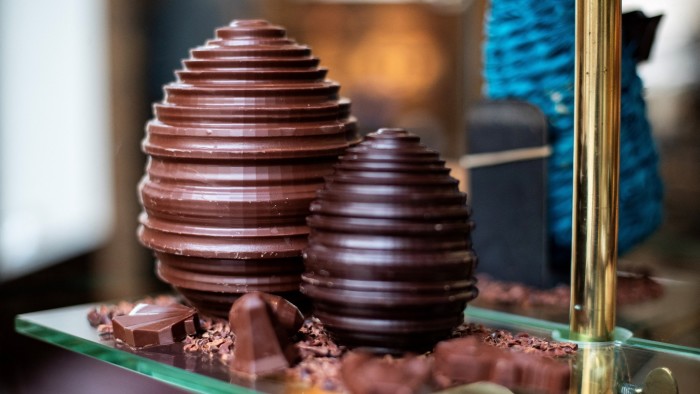Unlock the Editor’s Digest for free
Roula Khalaf, Editor of the FT, selects her favourite stories in this weekly newsletter.
Luxury chocolatiers are shrugging off volatile raw material costs to enjoy a boom in demand, saying some consumers are responding to the higher prices and reduced cocoa content in mass-market products by trading up to premium offerings.
Cocoa prices tripled last year as bad weather in the world’s main West African growing region hit harvests, with chocolate companies passing the cost to customers through higher prices.
Hershey’s and Oreo maker Mondelēz both warned on profits in February, after reporting a decline in sales volumes in 2024, while the confectionery division of Nestlé, which owns KitKat, reported a drop in sales last year.
Yet the premium end of the market is proving more resilient, aided by the bigger margins that help to absorb rising costs. High-end confectioners also note a counter trend amid the cost of living crisis, with regular consumers seeking out luxury items despite the higher prices.

“If a Mars bar is much more expensive than it used to be, people think ‘I might as well trade up’,” said Daniele Ferrero, chief executive of privately owned Venchi, whose premium Chocoviar Stracciatella Easter egg costs €44 in Italy, and £54 in the UK.
Giacomo Biviano, the head of Domori, the Italian chocolatier behind the Rococo and Prestat brands, said: “Even the low-quality product [now has] a very high price, so the consumer will choose the best.”
Luxury brands Neuhaus, Jeff de Bruges, Corné Port-Royal and Artista all delivered solid sales growth for Belgian parent Compagnie du Bois Sauvage last year, while Switzerland’s Läderach has doubled the size of its business over five years, said its chief executive Johannes Läderach.
By contrast, Barry Callebaut, the world’s largest chocolate manufacturer that supplies most of the world’s big confectioners, reported a drop in sales volume for the first half of the most recent fiscal year, blaming “unprecedented volatility” in cocoa markets.
Mondelēz chief executive Dirk Van de Put said this year that the company was navigating “unprecedented cocoa cost inflation” while Hershey’s noted in its annual report that it continued “to experience overall declines in consumer demands for our products”. Cocoa futures surpassed a record $12,000 per tonne in December, but have since fallen back below $8,500.

Neuhaus chief executive Isabel Baert said the premium brands “that maintain their quality and craftsmanship are better positioned to weather these market conditions”.
Many mainstream chocolate makers have been quietly reformulating recipes to protect profits from soaring costs, often cutting cocoa content and replacing it with other fats and flavourings.
Andrew Moriarty, an analyst at Mintec, said this should put premium chocolate makers in a “more difficult position” because their products have a higher cocoa content and “they have to stick to those ratios”.
Yet with luxury chocolatiers largely declining to reduce cocoa content and instead raising prices, customers mostly remained loyal.
“Even if the consumer wouldn’t know,” said Läderach, “it would destroy the premium culture which we want to celebrate. Our business case proves you can have chocolate of the highest standard . . . and get the price for it.”

Venchi’s Ferrero saw further scope for the premium brands to profit from the problems of the wider confectionery industry should cocoa prices remain unpredictable.
“For every consumer that decides to buy super premium chocolate less frequently, hopefully we’ll have two consumers that trade up from mass-market chocolate to premium chocolate,” he said.
“If you were buying a Mars bar, were you actually a chocolate lover anyway?” he asked. “How much chocolate are you getting in a KitKat?”
Nestlé said the recipe for KitKat had not changed, adding that the chocolate bar’s popularity demonstrated “the continuous appeal of well-established brands that offer tasty products.” Mars did not respond to a request for comment.
https://www.ft.com/content/f119b460-ebe5-47e2-a536-040bbf5d217c


